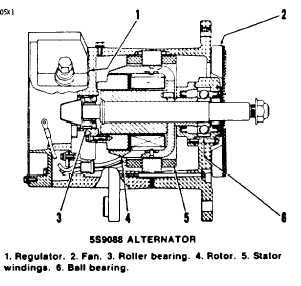ELECTRICAL SYSTEM
ELECTRICAL SYSTEM
SYSTEMS OPERATION
TM 5-3805-263-14&P-2
The electrical system has three separate circuits:
the charging circuit, the starting circuit and the
lighting circuit. Some of the electrical system com-
ponents arc used in more than one circuit. The bat-
tery (batteries). disconnect switch. circuit breaker,
ammeter. cables and wires from the battery are all
common in each of the circuits.
The charging circuit is in operation when the en-
gine is running. An alternator makes electricity for
the charging circuit. A voltage regulator in the cir-
cuit controls the electrical output to keep the battery
at full charge.
CAUTION
The disconnect switch must be in the ON
position to let the electrical system function.
There will be damage to some of the charging
circuit components if the engine is running
with the disconnect switch in the OFF posi-
tion.
The starting circuit can operate only after the
disconnect switch is put in the ON position.
The starting circuit is in operation only when the
start switch is activated.
The low amperage circuit and the charging circuit
are both connected through the ammeter. The start-
ing circuit is not connected through the ammeter.
CHARGING SYSTEM COMPONENTS
Alternator (Delco-Remy)
The alternator is driven by V-type belts from the
crankshaft pulley. This alternator is a three phase.
self-rectifying charging unit, and the regulator is
part of the alternator.
This alternator design has no need for slip rings or
brushes, and the only part that has movement is the
rotor assembly. All conductors that carry current are
stationary. The conductors are: the field winding,
stator windings, six rectifying diodes and the regula-
tor circuit components.
The rotor assembly has many magnetic poles like
fingers with air space between each opposite pole.
The poles have residual magnetism (like permanent
magnets) that produce a small amount of magnet-
like lines of force (magnetic field) between the poles.
As the rotor assembly begins to turn between the
field winding and the stator windings, a small
amount of alternating current (AC) is produced in
the stator windings from the small magnetic lines of
force made by the residual magnetism of the poles.
This AC current is changed to direct current (DC)
when it passes through the diodes of the rectifier
bridge. Most of this current goes to charge the bat-
tery and to supply the low amperage circuit, and the
remainder is sent on to the field windings. The DC
current flow through the field windings (wires
around an iron core) now increases the strength of
the magnetic lines of force. These stronger lines of
force now increase the amount of AC current pro-
duced in the stator windings. The increased speed of
the rotor assembly also increases the current and
voltage output of the alternator.
The voltage regulator is a solid state (transistor,
stationary parts) electronic switch. It feels the vol-
tage in the system and switches on and off many
times a second to control the field current (DC cur-
rent to the field windings) for the alternator to make
the needed voltage output.
Alternator (Robert Bosch)
The alternator is driven by two V-type belts. It
has a three phase full wave rectified output. The
alternator is brushless.
The rotor (4) and the bearings are the only moving
parts. The alternator output is 50 amp.
The main parts of the alternator are the stator
(2) which has three phase windings, the rectifier (3)
which changes the three phase AC to DC and pro-
vides excitation current.
1-21

